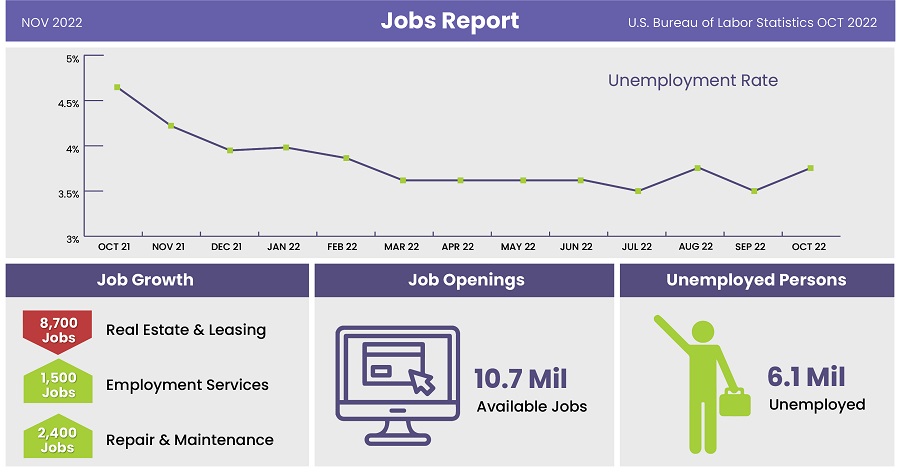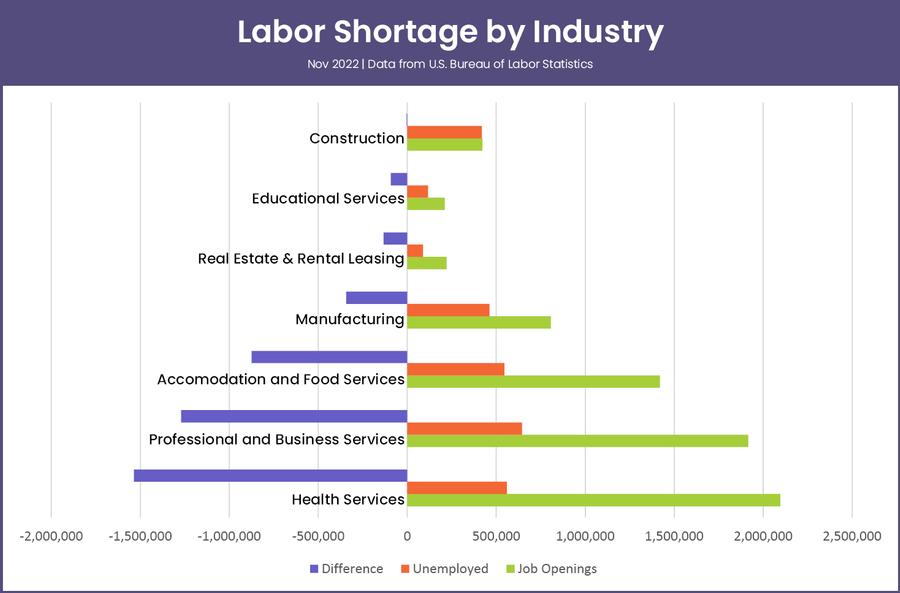Before You Go!
Sign up for our newsletter - which features professional templates, job market updates, articles, playlists, recipes, and more, sent directly to your inbox!



In the latest from the Bureau of Labor Statistics (BLS), the number of available jobs were reported to have increased by nearly half a million to 10.7 million following a sharp decline in August. The unemployment rate also rose to 3.7% by the end of October.
If job openings are once more increasing, why so is unemployment? In order to better understand today’s job market, it’s important to understand where the biggest gaps in the labor market are and then take a deep dive into public sentiment and trending movements.

As you can see from the chart above, the industries experiencing the highest gap in the labor force are the Health Services, Professional and Business Services, and Accommodation and Food Services industries. With 1.5 million more available jobs than available people, the Health Services industry is currently facing the largest labor shortage in the market today while industries such as Construction are seeing a near equal amount of available jobs to available people.
However, it is interesting to note that while there are nearly equal amounts of available jobs to available people in Construction, it still has a high number of unemployed persons with a total of 419,000 unemployed. This isn’t the only industry that is seeing this kind of behavior. For example, retail currently holds the highest number of unemployed persons of any industry today at 882,000 unemployed (it actually has a surplus of unemployed persons) but available jobs in retail remained at nearly 800,000 with little change from the previous month.
With voluntary quits still remaining above 4% throughout 2022 and the employment to population ratio seemingly unchanged at 60%, we need to ask ourselves where the other 40% is and why there are so many people not working.
Amid recent labor shortages and quiet quitting, the anti-work movement has gained steam. While the anti-work movement is not a new movement, labor shifts from the pandemic and heightened participation on various social platforms has made this movement drastically grow in popularity over the last couple of years. The anti-work movement isn’t exactly as the name implies. Those for the movement are not against working, but rather they are advocating a shift away from paid labor and toward voluntary and fulfilling work.
A few years ago, the anti-work movement was a radical idea until the pandemic pushed the growth of this idea into the mainstream and it has become more widely known and accepted. “Having worked themselves to the bone during the pandemic, people are now searching for a change of lifestyle, and a healthier, happier way of working for a living,” says Forbes.
People are aware that they have to work for a living, but they are growing more and more concerned about how they work. Demand for higher wages, flexible working hours, remote opportunities, and better benefits has fueled this movement in many of the younger working generation. A recent demographic survey of the movement found that the majority of active participants were under the age of 35. People under the age of 35 make up 79.7% of today’s current labor force according to the Bureau of Labor Statistics. So what can employers do in light of this and other recent labor movements?
Employers should respond by evaluating their labor practices. Those employers who are actively working to redefine the traditional workplace structure and meet jobseeker expectations are the ones who are going to continue to succeed in today’s highly competitive market.
JWilliams Staffing is here to help your company navigate the workforce. We have a strong network of job seekers who are ready to work, and expert recruiters who carefully screen, train, and identify the cross application of skillsets in candidates necessary to excel in their career. Learn more about our temporary and direct hire staffing services today!
Sources:
Bureau of Labor Statistics. (2022a, Nov). JOB OPENINGS AND LABOR TURNOVER – SEP 2022. https://www.bls.gov/news.release/pdf/jolts.pdf
Bureau of Labor Statistics. (2022b, Nov). THE EMPLOYMENT SITUATION — OCT 2022. https://www.bls.gov/news.release/pdf/empsit.pdf
